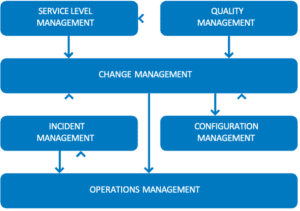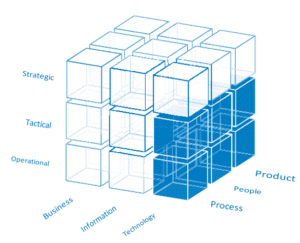ISM in 3 minutes
The basics
All service delivery organizations have the same goals and are therefore capable of using the same basic IT processes. With only seven fundamental processes, every IT-organization can do their work on A tactical and operational level.
IT Service management is more alive than ever. It’s about organizing Service Delivery. It might have started with ITIL, but nowadays it includes ABC, agile, LeanIT, DevOps, OBM etc.
Integrating all these meaningful designs and models into one solution wherein each can fulfill its necessary role is one of the exciting challenges for the coming years.

Processes are meant to support IT professionals in executing their profession, not to control them. Processes should follow and
support the natural professional behavior and increase flow and quality. Staff and management should be able to use the model.
Summary
The ISM Method, first published in 2010, describes clearly the need for a compact process model to support the professional IT service delivery. The ISM model applies the lessons learned from ITIL by reducing the amount of processes and translates them in a complete and compact model.

The focus of ISM is on result, service delivery, and therefore the model must be simple and applicable. Only applicable knowledge is useful.
Service management is considered to be the profession that it organizes the way in which IT departments work. Therefore the ISM Method aligns all resources, People, Processes and
Products, that are necessary to realize operational excellence in a process oriented way.

Organizational change is the cornerstone / backbone of the ISM Method. How to become an excellent service delivery organization. Leadership, clear distinction of roles, and especially a phased and structured approach to increase service excellence with a fundamental role of IT Management.
Other important elements are:
• Clear distinction of the position of Technical Management (the area of ISM®) and Information Management (the area of FSM®)
• The relation between People, Process and Product, the organizational resources
• The relation between process management and line management
• The ISM process model and the relation between the processes
• The fundamental role of the 6 basis processes, covering all activities on a tactical and operational level
• The emphasis on a phased implementation, introducing processes is changing the way of working
– phase I the installation of all the People, Process and Product resources
– phase II implementation wherein an organization learns to work with the processes and to continually improve
• Clear distinction between processes and functions
• The usage of clear definitions – more than 600 terms easily explained
Target audience
• IT Managers – who realize that excellent services are delivered by well-organized teams wherein IT professionals closely work together, and are guided by clear and compact processes. Managers who realize that they have to facilitate the growth of their staff and organization to a more mature and flexible level
• Process managers – who want their process to support the service delivery, to become in control and not to control. Managers that want to focus on flow and flexibility and not on designing processes and tools
• Team leads – who want to facilitate their staff with proper understanding of the value of process oriented working
• IT professionals – who want to professionalize their way of working by using IT-processes to improve their performance
• IT service management consultants – who want to help organizations to grow to service excellence by introducing applicable processes
• IT service management trainers – who want to train managers and staff in modern service management
Scope and constraints
The ISM Method combines best practices and a structured design. It’s simple to choose to make it applicable and manageable for every IT department.
Strengths
• Easy to apply
• Complete and compact on a tactical and operational level
• All resources covered and aligned (People, Process and Product)
• Free of organizational structures, re-organizations do not influence the processes
• Ready for hybrid organizations wherein classical knowledge teams (silos), projects, outsourcing and service teams (like in DevOps) are combined.
• One size fits all
• Proper preparation for compliancy and security
Constraints
• Limited to IT management
• Limited in the way of organizing the work / the way of working, technical skills are not part of the method
• Organizational structures are not included or prescribed, the model should fit in any organizational structure
• Although the method is complete and ready to use, growing to service excellence will still need a phased and persistent approach from all involved players